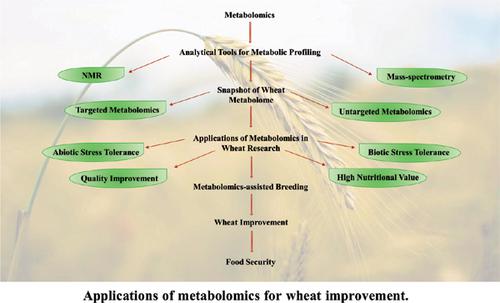Protein & Peptide Letters ( IF 1.0 ) Pub Date : 2021-07-31 , DOI: 10.2174/0929866528666210127153532 Ali Razzaq 1 , Wajiha Guul 2 , Muhammad Sarwar Khan 1 , Fozia Saleem 1

|
Wheat is a widely cultivated cereal, consumed by nearly 80% of the total population in the world. Although wheat is growing on 215 million hectares annually, its production is still inadequate to meet the future demand of feeding the 10 billion human population. Global food security is the biggest challenge as climate change is threatening crop production. There is a need to fast-- track the wheat breeding by devising modern biotechnological tools. Climate-smart wheat having greater stress resilience, better adaptability and improved agronomic traits are vital to guarantee food security. Substantial understanding and knowledge of vital biochemical pathways and regulatory networks is required for achieving stress resilience in wheat. Metabolomics has emerged as a fascinating technology to speed up the crop improvement programs by deciphering unique metabolic pathways for abiotic/biotic stress tolerance. State-of-the-art metabolomics tools such as nuclear magnetic resonance (NMR) and advanced mass spectrometry (MS) has opened new horizons for detailed analysis of wheat metabolome. The identification of unique metabolic pathways offers various types of stress tolerance and helps to screen the elite wheat cultivars. In this review, we summarize the applications of metabolomics to probe the stress-responsive metabolites and stress-inducive regulatory pathways that govern abiotic/biotic stress tolerance in wheat and highlight the significance of metabolic profiling to characterize wheat agronomics traits. Furthermore, we also describe the potential of metabolomics-assisted speed breeding for wheat improvement and propose future directions.
中文翻译:

代谢组学:研究小麦代谢组复杂性的强大工具
小麦是一种广泛种植的谷物,被世界上近 80% 的人口消费。尽管小麦每年种植面积达 2.15 亿公顷,但其产量仍不足以满足未来养活 100 亿人口的需求。由于气候变化威胁着作物生产,全球粮食安全是最大的挑战。需要通过设计现代生物技术工具来快速跟踪小麦育种。气候智能型小麦具有更强的抗逆性、更好的适应性和改良的农艺性状,对于保障粮食安全至关重要。实现小麦的逆境恢复需要对重要的生化途径和调控网络有深入的了解和了解。代谢组学已成为一项引人入胜的技术,通过破译非生物/生物胁迫耐受性的独特代谢途径来加速作物改良计划。核磁共振 (NMR) 和高级质谱 (MS) 等最先进的代谢组学工具为小麦代谢组的详细分析开辟了新视野。独特的代谢途径的鉴定提供了各种类型的胁迫耐受性,有助于筛选优良的小麦品种。在这篇综述中,我们总结了代谢组学在探索小麦非生物/生物胁迫耐受性的胁迫响应代谢物和胁迫诱导调节途径中的应用,并强调了代谢谱在表征小麦农艺性状方面的重要性。此外,











































 京公网安备 11010802027423号
京公网安备 11010802027423号